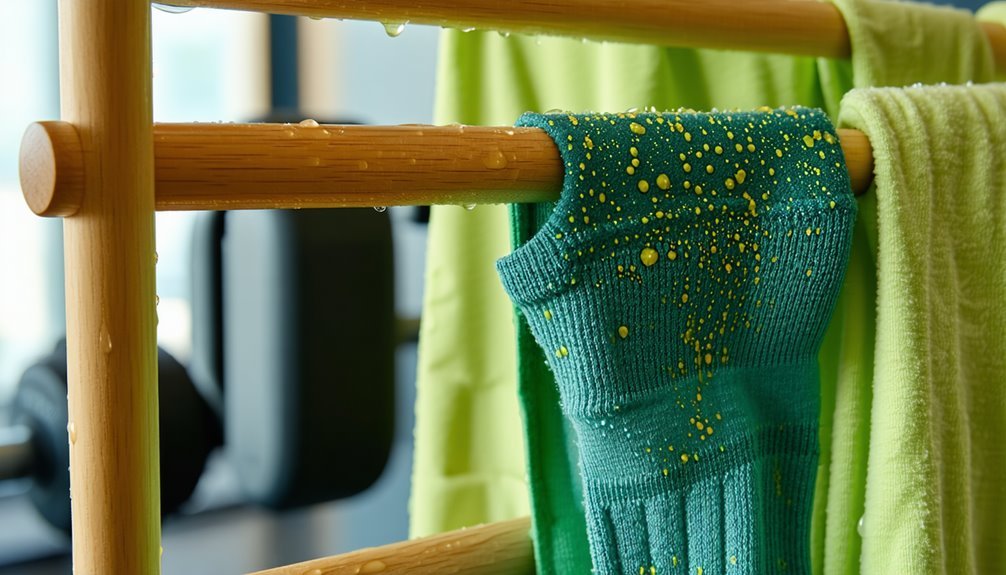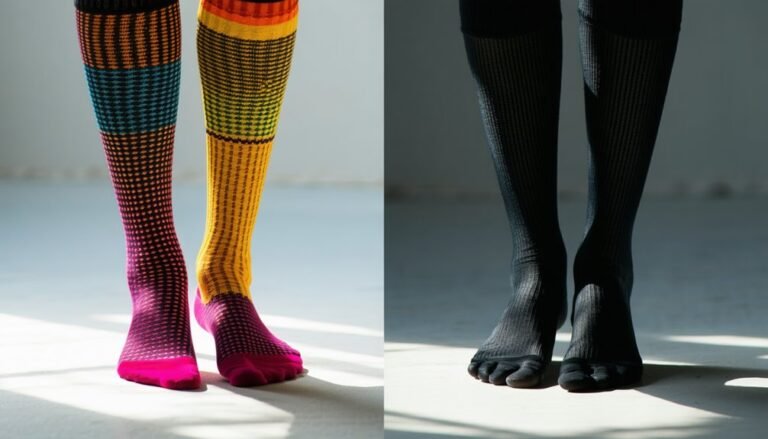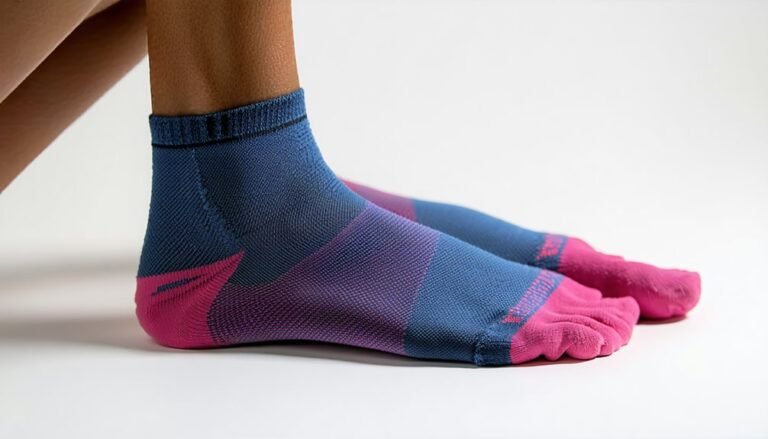Can Sport Socks Get Moldy
Yes, sport socks can get moldy, especially if they're damp and stored improperly. Mold thrives in warm, moist environments, so sweaty feet and confined storage can promote growth. Signs of mold include musty odors, discoloration, and visible fuzzy patches. Moldy socks can lead to health risks like allergies and skin irritations, making it essential to maintain proper sock hygiene. To keep your socks in good condition, you should follow best washing practices and preventive measures, which you'll learn about next.
Understanding Mold Growth in Sport Socks

Mold growth in sport socks is a common issue that can arise under certain conditions. Understanding the mold lifecycle is vital for preventing contamination. Mold spores thrive in environments with excess moisture, warmth, and organic materials, all of which can be present in damp socks. To effectively prevent mold, moisture control is imperative. Make certain your socks are completely dry before storage and consider using breathable fabrics that wick moisture away from your skin. Regular washing with appropriate detergents can also help eliminate spores. By maintaining a dry environment and practicing proper care, you can greatly reduce the risk of mold growth in your sports socks, guaranteeing a safer and healthier experience during your athletic activities.
Common Causes of Mold in Athletic Footwear
Athletic footwear can easily become a breeding ground for mold if not properly maintained. To prevent mold growth, it's essential to address common causes:
- Excessive Moisture: Sweaty feet or wet conditions can lead to trapped moisture.
- Poor Air Circulation: Storing shoes in a closed space without ventilation can create a humid environment.
- Lack of Moisture Control: Not using moisture-wicking socks or breathable materials can exacerbate dampness.
- Neglected Cleaning: Failing to clean shoes regularly allows dirt and sweat to accumulate, promoting mold.
Signs Your Sport Socks May Be Moldy
If you notice an unpleasant odor coming from your sport socks, it could be a sign of mold. Additionally, keep an eye out for visible mold growth or any discoloration and stains on the fabric. Addressing these signs early can help prevent further issues.
Unpleasant Odor Detection
How can you tell if your sport socks have fallen victim to mold? One of the most notable signs is an unpleasant odor. Mold thrives in environments with moisture retention, and this can lead to various odor sources. Here are some indicators your socks may be moldy:
- Musty Smell: A strong, damp odor is a key sign of mold presence.
- Funky Foot Odor: If your feet smell worse than usual after wearing the socks, mold could be responsible.
- Sour Smell: An unusual sour scent often indicates trapped moisture and potential mold growth.
- Lingering Odor: If odors persist even after washing, it's time to replace the socks to guarantee safety and hygiene.
Visible Mold Growth
While odors can signal the presence of mold, visible signs are often more definitive. When inspecting your sport socks, look for any fuzzy or discolored patches, which may indicate mold growth. These patches can be gray, green, or black and typically appear in damp areas. Utilizing mold identification techniques, such as checking the sock's seams and folds, can help you detect hidden mold. If you notice any of these signs, it's vital to address the issue immediately to prevent health risks. Additionally, proper sport sock storage is important; keep them in a dry, well-ventilated area to minimize moisture buildup. Regularly inspect your socks to verify they remain mold-free and safe for use.
Discoloration and Stains
What signs should you look for to determine if your sport socks are moldy? Discoloration and stains are key indicators. Here are four signs to watch for:
- Yellow or Brown Stains: Often a result of sock discoloration causes such as moisture retention.
- White Powdery Residue: This can indicate mold spores forming on the fabric.
- Unpleasant Odor: A musty smell can signal the presence of mold.
- Faded Color: If your socks appear washed out, it may be due to mold damage.
To address these issues, consider effective stain removal techniques like soaking in vinegar or using specialized detergents. Regularly inspect your socks to guarantee they stay mold-free and safe for use.
Health Risks Associated With Moldy Socks

Since mold thrives in warm, damp environments, wearing moldy socks can pose significant health risks. Mold spores can lead to various health implications, especially for individuals with compromised immune systems or pre-existing respiratory conditions. You might experience allergic reactions, such as sneezing, itching, or skin rashes, after prolonged contact with moldy fabrics. Additionally, the presence of mold can exacerbate asthma symptoms and other respiratory issues, making it important to address any mold growth promptly. Even if you're not allergic, inhaling mold spores can lead to irritation of the eyes, skin, and throat. It's vital to guarantee your socks are clean and dry to minimize these risks and maintain your overall health and well-being.
Best Practices for Washing and Drying Sport Socks
To keep your sport socks in top condition and prevent mold, you need to use the right washing techniques. Start with cold water and a gentle detergent, which helps maintain the fabric's integrity while removing sweat and odor. After washing, proper drying methods—like air drying or using a low-heat setting—are essential to eliminate any remaining moisture.
Washing Techniques for Socks
When it comes to keeping your sport socks fresh and free from mold, employing the right washing techniques is crucial. To maintain the integrity of the sock material and guarantee cleanliness, adhere to these best practices:
- Wash Frequency: Aim to wash your socks after each use, especially after intense workouts.
- Water Temperature: Use warm water to effectively remove sweat and bacteria without damaging the fabric.
- Detergent Choice: Opt for a mild, sports-specific detergent to preserve the sock material and enhance odor removal.
- Avoid Fabric Softeners: These can coat the fibers, reducing moisture-wicking properties and promoting mold growth.
Following these guidelines will help you prolong the life of your sport socks while keeping them safe and hygienic.
Proper Drying Methods
While washing your sport socks correctly is essential, proper drying methods are equally important to prevent mold and maintain their performance. To guarantee proper ventilation, avoid leaving your socks in a damp laundry basket. Instead, dry them in a well-ventilated area. If possible, hang them up or use a drying rack to allow air to circulate freely.
When using a dryer, opt for low heat settings to prevent damage. Avoid overloading the dryer, as this can restrict airflow. You might also consider air drying outside on a sunny day, as UV rays help eliminate bacteria and odors. Whichever drying techniques you choose, make sure your socks are completely dry before storing them to minimize the risk of mold growth.
Tips for Preventing Mold in Your Footwear
Preventing mold in your footwear is essential, especially if you live in a humid climate or frequently engage in physical activities. Implementing effective preventative measures can greatly enhance moisture control and keep your shoes mold-free. Here are some tips:
- Dry Shoes Properly: Always make sure your shoes are completely dry after use. Remove insoles and let them air out.
- Use Moisture-Absorbing Inserts: Consider using silica gel packets or other moisture-absorbing products to combat humidity.
- Store Footwear in a Cool, Dry Place: Avoid keeping shoes in damp areas; opt for well-ventilated spaces.
- Regularly Clean Shoes: Keep footwear clean by washing them regularly to prevent mold growth from sweat and dirt.
Adopting these practices will help maintain a safe and healthy environment for your feet.
When to Replace Your Sport Socks
Although sport socks may seem durable, their effectiveness diminishes over time due to wear and tear. You should consider replacing your sport socks once they show signs of fraying, thinning, or loss of elasticity. Generally, the lifetime expectancy of sport socks varies based on sock materials; synthetic blends often last longer than cotton. If you notice persistent odors or dampness, it's time for a change, as these can indicate mold growth or degradation. Regularly inspect your socks after rigorous use, especially post-training sessions. Prioritizing sock integrity not only enhances comfort but also helps prevent foot injuries and mold-related issues. Remember, investing in quality sport socks is essential for both performance and safety.
Frequently Asked Questions
Can Moldy Sport Socks Be Cleaned and Reused?
When it comes to cleaning moldy sport socks, you can't judge a book by its cover. Effective cleaning methods include hot water and vinegar. Proper sock care guarantees safety and helps prevent future mold growth.
How Long Does It Take for Mold to Grow on Socks?
Mold can start growing on socks within 24 to 48 hours in humid conditions. For mold prevention, guarantee proper sock storage in a cool, dry place, avoiding damp areas to minimize the risk of mold development.
Do Different Materials Affect Mold Growth in Sport Socks?
Different materials do affect mold growth in sport socks. Fabrics with high moisture retention, like cotton, can foster mold, while synthetic materials often resist moisture, reducing mold risks. Always choose moisture-wicking options for better safety and hygiene.
Can Mold Spores Survive After Washing Sport Socks?
Mold spores may manage to survive despite washing effectiveness. If you don't thoroughly clean your sport socks, these resilient spores can linger, creating potential health hazards. Always guarantee proper washing techniques to eliminate this risk.
Are Certain Brands of Sport Socks More Prone to Mold?
Certain brands of sport socks may be more prone to mold due to their materials and sock features. Brand comparisons reveal that moisture-wicking properties and antimicrobial treatments can greatly reduce mold risk, enhancing your safety during use.





